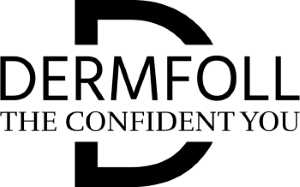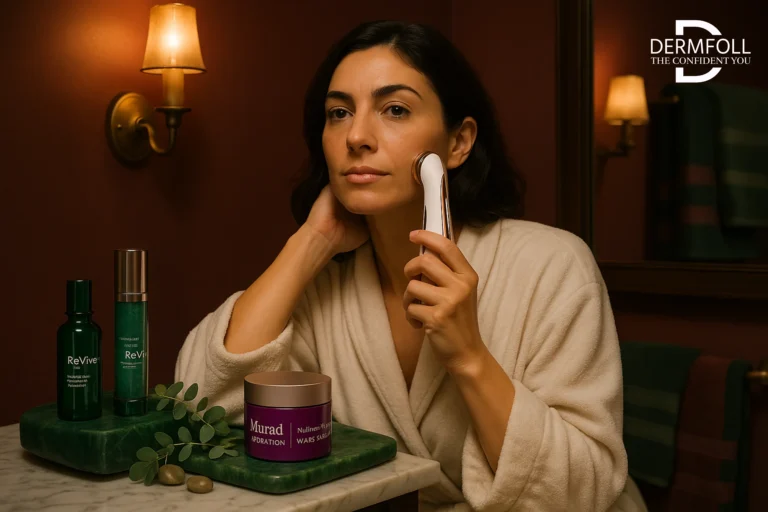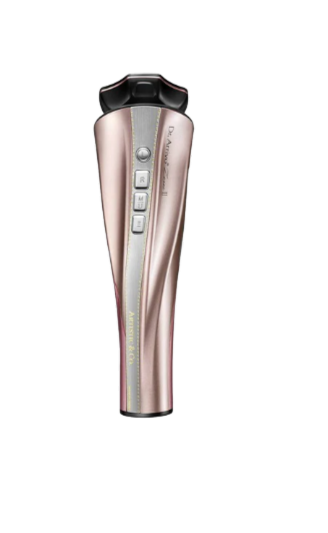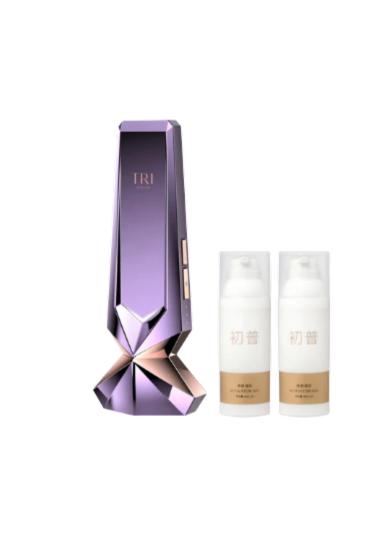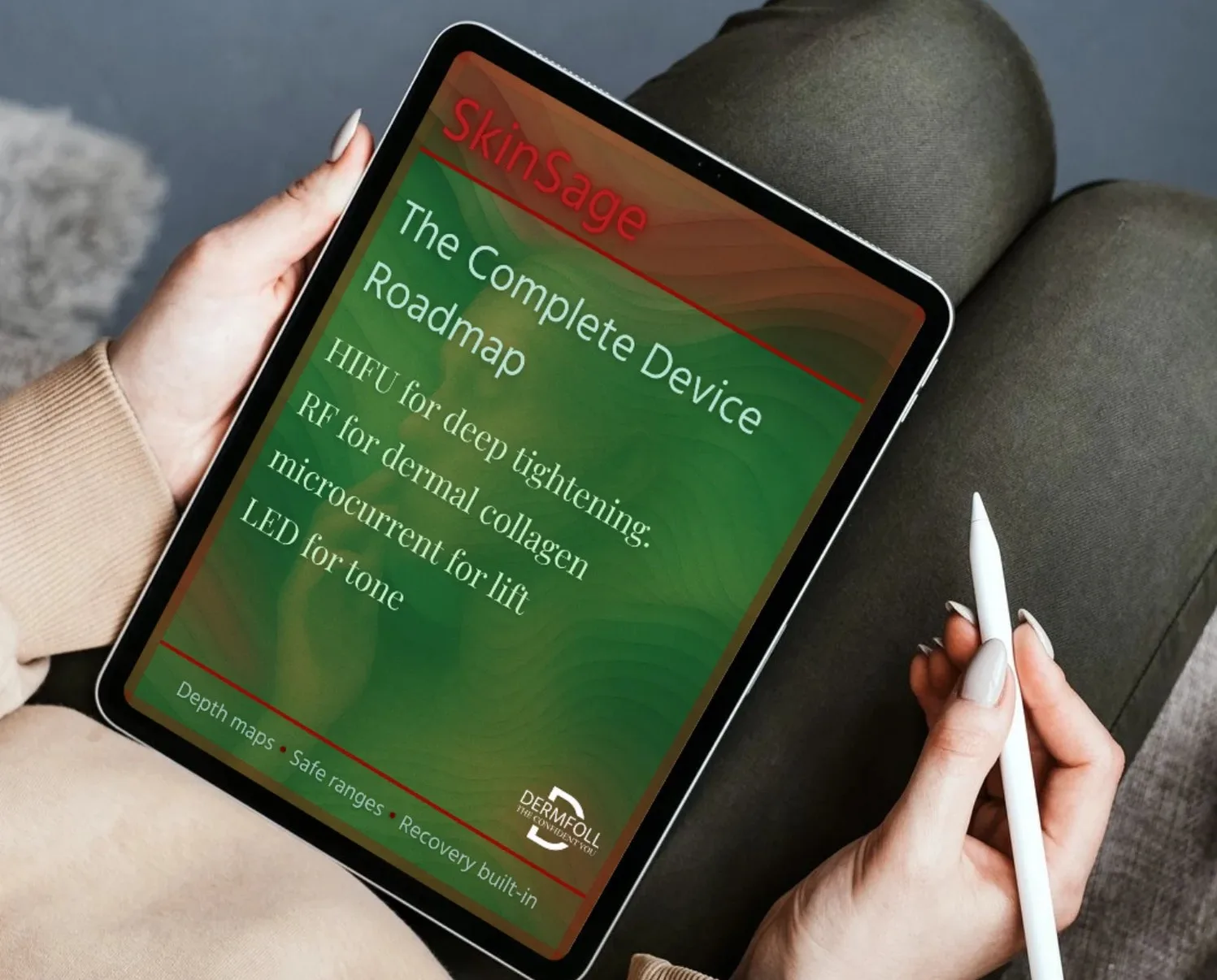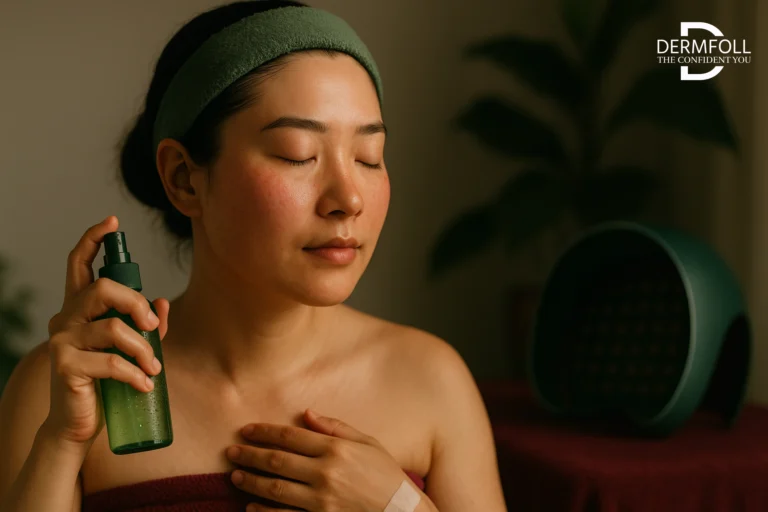RF Technology Fundamentals
Understanding RF Technology Fundamentals
I know it can feel a bit overwhelming when you first hear about Radio frequency skin tightening devices – it sounds high-tech, right?
Think of it like a gentle warming hug for your skin. When you use an At Home RF Skin Tightening gadget, it sends invisible electric waves into your skin layers.
These waves create tiny amounts of heat (thanks to something called Joule heating), which encourages your collagen fibers—those stretchy bands that keep your skin firm—to tighten up.
You might wonder, “Is this like a mini sauna for my face?” Kind of! But it’s much more controlled. Safe devices aim for around 40°C to 48°C on the surface—warm enough to wake up collagen without harming deeper tissues.
As one study puts it, “When skin reaches about 40°C to 48°C, the heat makes collagen fibers loosen,” helping you see that subtle lift and glow after each session.
Give it a try a few times, and you’ll notice that familiar “warm and pleasant” sensation as your face tightening tool does its thing. Cool, right?
“When skin reaches about 40°C to 48°C, the heat makes collagen fibers loosen.”
Collagen & Elastin Remodeling: What the Science Shows
What’s happening beneath the surface? After consistant cozy heat session, your skin does snap back gradualy and it goes to work building new support structures.
Collagen, which we just woke up, starts to rebuild over the next few weeks. At the same time, your skin makes more elastin, the protein that helps it bounce back.
In a split-face study using a professional RF device, researchers measured real, crunchy data: treated skin showed a 7.9% increase in collagen content and a 34.7% jump in collagen synthesis compared to untreated areas.
That’s your skin literally rebuilding itself stronger than before.
Whether you’re using a Dr. Arrivo ZEUS II or a TriPollar STOP Vx3, both of these Radio frequency skin tightening devices tap into that same biology.
You’ll feel results a bit differently—maybe a subtle firmness here, a smoother texture there—but the underlying remodeling story is the same:
heat prompts collagen renewal and elastin boost, giving you firmer, more resilient skin over time.
“Treated skin showed a 7.9% increase in collagen content and a 34.7% jump in collagen synthesis.”
Comparing Treatment Settings
Home vs. Clinic: Power and Precision Compared
You must be curious how your face tightening tool stacks up against a pro setup.
In a clinic, machines can run higher power levels – Often in the range of 13 to 21 J/cm²—so they heat deeper layers of skin and fat more quickly.
By contrast, At Home RF Skin Tightening devices dial down the intensity to keep things safe for everyday use, especially if you have ADHD like myself :’).
That means you won’t get quite the same rapid, deep effect, but it also greatly reduces any chance of burns or unwanted fat loss.
“Professional radio frequency skin tightening devices generate more energy and produce deeper heat.”
Think of it like driving a sports car versus a family sedan. The sedan won’t hit 200 mph, but it’s far easier and safer to handle on city streets—and you still arrive at your destination in style.
Which kind of ride feels right for your skincare journey?
Finding the Sweet Spot: Safe Temperatures for RF Devices
Now let’s zero in on temperature. Your goal is a cozy 40 °C to 48 °C at the skin surface—warm enough to trigger collagen tightening without venturing into “fat-melting” territory.
Studies show that fat cells can start breaking down at around 41 °C and die off quickly near 70 °C, so there’s a pretty fine line.
Good Radio frequency skin tightening devices use real-time sensors to keep you in that Goldilocks zone.
“Fat melting can occur as early as 41 °C, while fat cells begin to die quickly at around 70 °C.”
Both the Dr. Arrivo ZEUS II and TriPollar STOP Vx3 have built-in thermistors that automatically adjust power if you get too hot.
It’s like having a smart thermostat for your face. How would knowing your device pauses itself if it senses danger change your confidence in using it?

Device Selection Criteria
“Devices delivering more than 13 J/cm²—especially when used repeatedly and for long sessions—can damage fat cells beneath the skin.”
Choosing a Radio frequency skin tightening device isn’t just about picking the flashiest model. You want the right balance of safety and efficacy. Let’s break down what really matters.
Key Features to Look for in Your face tightening tool
Real-time thermistors
These are tiny temperature sensors that keep checking your skin’s warmth and dial power up or down. It’s like cruise control for your treatment – steady speed without surprises.
Multi-polar tips
Instead of one hot spot, these spread energy evenly across the surface. Think of a diffuser on a hairdryer: gentle, wide coverage rather than a laser-focused beam.
Auto shut-off
A built-in timer or sensor that stops the device when you’ve hit the recommended treatment time or temperature. It’s your built-in safety net.
Adjustable power settings
Being able to step up or dial back intensity means you can tailor sessions to your comfort level or skin sensitivity.
Clinical validation
Look for devices with published studies or FDA clearance. That extra layer of proof gives you confidence you’re not just buying marketing hype.
Conductive gel requirement
A good At Home RF Skin Tightening gadget will specify its own gel or serum. Using the right medium ensures energy flows smoothly and safely into your skin.
Avoiding Unwanted Fat Loss: Depth, Tips, and Settings
“Fat can heat faster than collagen because it has higher impedance.”
Yes, heat can tighten collagen – but push too deep or too hot, and you risk melting fat you’d rather keep. Here’s how to stay in the safe zone:
Know the penetration depth
Devices vary in how deep their RF goes. Shallower treatments focus on skin tightening, while deep-penetrating tools can reach subcutaneous fat.
If you’re worried about hollowness, stick with mid-depth settings.
Pick larger electrode surfaces
Bigger tips spread energy over a wider area, reducing the risk of over-focusing heat. It’s like pressing a warm hand against your cheek instead of poking it with a hot poker.
Monitor energy density (J/cm²)
Lower-powered at-home tools often cap around 5–10 J/cm². Keeping sessions within that range helps you avoid the 13 J/cm² “red flag” zone where fat damage becomes likely.
Limit session length and frequency
Even the best Dr. Arrivo ZEUS II or TriPollar STOP Vx3 can overheat if held too long in one spot. Stick to the manufacturer’s recommended time per area (usually 3–5 minutes) and give yourself at least 24 hours before targeting the same zone again.
By focusing on these features and settings, you’ll get the tightening benefits without worrying about unintended volume loss.
Ready to pick your ideal tool? Let me know what features you find most important!
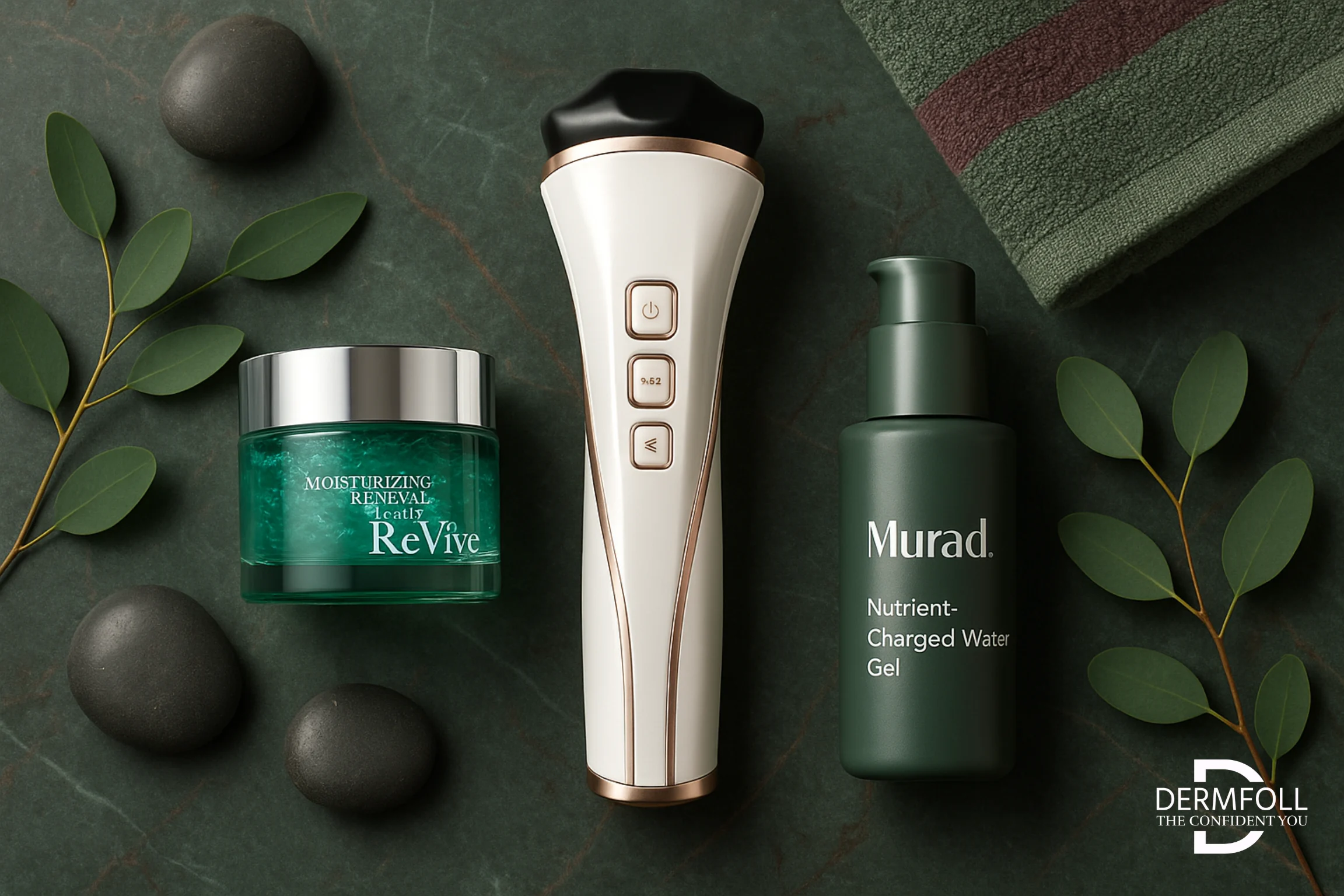
Enhancing Results with Topicals
“High water content allows radio-frequency energy to transmit efficiently into the dermis.”
Alright, let’s make your At Home RF Skin Tightening sessions even more effective and comfortable.
In addition to the standard Conductive gel, here are some add-ons that can boost your results.
Think of these skincare steps as the backstage crew for your face tightening tool, ensuring it performs at its best and your skin looks radiant afterward.
Topical Allies: Serums, Gels, and Creams to Enhance RF Sessions
Conductive Gel Add-on – RéVive Moisturizing Renewal Hydrogel
I like to call this the “slippery foundation.” It’s a true hydrogel loaded with four sizes of hyaluronic acid plus soothing aloe and chamomile.
This water-rich texture helps your Radio frequency skin tightening devices like the Dr. Arrivo ZEUS II or TriPollar STOP Vx3 glide smoothly, so you avoid any hotspot or patchy heating.
Hydrating Serum – Murad Nutrient-Charged Water Gel
After you’ve warmed and tightened, your skin is thirsty. Murad’s gel uses “Cumulative Hydration” technology—peptides, vitamins, and minerals lock in moisture for up to five days.
Soothing Cream – Murad Heartleaf Calming Cream Moisturizer
Energy treatments can leave a bit of redness. This fragrance-free cream, rich in ceramides and fermented heartleaf extract, calms irritation and strengthens your barrier within a week.
It’s like giving your skin a cozy blanket after a workout.
Antioxidant Booster – RéVive Brightening Serum
Finish off with a protective shield. This blend of Vitamin C (THD-Ascorbate), niacinamide, and peptides fights free radicals and soothes inflammation.
Apply it under your daytime SPF, and you’ve got long-lasting defense against environmental stressors.
How to Layer for Maximum Benefit
- Prep: Spread a thin, even coat of RéVive Hydrogel so your Radio frequency skin tightening device can do its job.
- During RF: Glide your Dr. Arrivo ZEUS II or TriPollar STOP Vx3 as instructed—no rush, gentle strokes.
- Post-Care: Pat on Murad Water Gel to quench deep layers.
- Calm & Seal: Massage in Murad Heartleaf Cream to soothe and reinforce your skin barrier.
- Protect: Lock everything in with RéVive Brightening Serum before sunscreen.
This “plump and protect” routine turns each session into a complete treatment: you get smooth energy conduction, deep hydration, barrier repair, and antioxidant coverage.
User Experience & Practical Guidance
“Seventy-one point four percent of users felt comfortable throughout the procedure.”
Let’s talk about what real people say when they try At Home RF Skin Tightening devices. Their feedback gives us a clear sense of comfort, results, and how easy these gadgets really are to use.
User Satisfaction Snapshot: Comfort, Results, and Ease of Use
- Overall Satisfaction:
- 33.3 % Very Satisfied, 47.7 % Satisfied, 19 % Neutral
- Noticeable Improvement:
- 28.6 % Very Satisfied, 57.1 % Satisfied, 14.3 % Neutral
- Comfort Level:
- 71.4 % Very Comfortable, 14.3 % Comfortable, 9.5 % Neutral, 4.8 % Uncomfortable
Most people find their face tightening tool a breeze to use, with minimal discomfort and a pleasant warming sensation.
If you’re weighing the Dr. Arrivo ZEUS II against the TriPollar STOP Vx3, know that both enjoy strong “satisfied” scores – so you’re in good hands either way.
How does that line up with your comfort expectations?
Pro Tips for Maximizing At Home RF Skin Tightening Treatments
- Prep Smart: Always start with a clean face and the right conductive gel. A water-based hydrogel ensures your Radio frequency skin tightening device glides smoothly.
- Keep It Moving: Use gentle, sweeping motions. Think of smoothing butter on toast—steady and even, never lingering too long in one spot.
- Listen to Your Skin: If you feel any sharp heat or tingling, pause and let your skin cool for a moment. Your device’s auto shut-off helps, but your body’s warning sign is priority one.
- Follow the Clock: Stick to the recommended session time (usually 3–5 minutes per zone). Over-treating won’t boost results – it can backfire.
- Clean Up: Wipe down your face tightening tool after each use. A clean device means reliable energy delivery and fewer skin irritations.
- Stay Consistent: The magic really happens over weeks. Set a schedule – whether it’s twice a week with the Dr. Arrivo ZEUS II or maintenance sessions with the TriPollar STOP Vx3, regularity trumps intensity.
- Hydrate & Protect: Post-treatment, lock in moisture with a soothing gel or cream and finish with SPF. Healthy, protected skin responds better in the long run.
These simple habits help you get the most from your device without any guesswork. Ready to dial in your routine and see that glow every time?
Choosing the Right RF + Topical Routine
You’ve learned about heat, collagen boosts, safety features, and the post-care superheroes. Now, let’s pull it all together – like building your own skincare playlist.
Define Your Goal
- Want a gentle, salon-like lift? The Dr. Arrivo ZEUS II’s multipolar RF and EMS modes give you that “esthetician’s touch.”
- Looking for fast, targeted toning? The TriPollar STOP Vx3 shines with its Turbo RF and Dynamic Muscle Activation. Which outcome speaks to you?
Match Your Skin Type
- Sensitive or prone to redness? Lean on lower intensity settings and stick with the RéVive Hydrogel plus the Murad Heartleaf Cream combo.
- Thicker, more resilient skin? Feel free to ramp up slightly and follow with the Murad Water Gel and RéVive Brightening Serum for extra glow.
Set a Realistic Schedule
- Beginners: Start with two session per week, see how your skin reacts, then increase to 3–4 times weekly.
- Maintenance pros: 3 to 4 times a month keeps results fresh without overdoing it. Consistency beats cramming.
Layer with Purpose
- Prep with your hydrogel so your face tightening tool glides friction-free.
- Treat per device instructions – slow, steady strokes.
- Hydrate immediately after with a water-based gel.
- Soothe and seal with your calming cream.
- Boost antioxidants under SPF to lock in defense.
Listen & Adjust
If your skin ever feels too warm or tight, pause and let it settle. Your comfort is the ultimate gauge of a safe, effective At Home RF Skin Tightening session.
By blending the right device—Dr. Arrivo ZEUS II or TriPollar STOP Vx3—with a tailored topical routine, you’ll create a ritual that’s both indulgent and results-driven.
Conclusion
We’ve taken a friendly deep dive into At Home RF Skin Tightening, unpacking how gentle radio waves firm collagen and boost elastin for that subtle lift.
You now know the trade-offs between a DIY device and clinic power, and which safety features—like real-time thermistors and multi-polar tips—keep you comfortable and protected.
We’ve paired our face tightening tool sessions with the perfect post-care squad: hydrogels for smooth gliding, water gels for deep hydration, calming creams for redness relief, and antioxidant serums to lock in protection.
Real user feedback shows these routines are not only effective but also pleasant and easy to stick with.
Most importantly, you’re equipped to choose between game-changing options like the Dr. Arrivo ZEUS II and TriPollar STOP Vx3, then craft a schedule and topical lineup that feels right for your skin type and lifestyle.
Curious if your facial structure should change the way you use RF at home? Or wondering whether some devices are better suited for your specific needs?
👉 Read the next post: Facial Tightening Tools Gone Too Far? How to Spot Fat Loss and Rebuild Volume Safely
